#scandal review
Explore tagged Tumblr posts
Text

Grrrr mr gallagher... 😳
This drawing was made in collaboration with VEIKK Tablet who have kindly sent me to review their Creator VK1060 Pro. If you're interested, pls click this link for 21% OFF your purchase!



#hiiii its your baby's first review collab 🥹#i actually got this collab offer sometime back in january when wacom got into the ai promo scandal#which is fucking hilarious to me when you think about it#veikk knows what they were doing lol#honkai star rail#hsr#gallagher#gallagher hsr#my art
1K notes
·
View notes
Text
By: Jesse Singal
Published: Jun 27, 2024
In April Hilary Cass, a British paediatrician, published her review of gender-identity services for children and young people, commissioned by NHS England. It cast doubt on the evidence base for youth gender medicine. This prompted the World Professional Association for Transgender Health (WPATH), the leading professional organisation for the doctors and practitioners who provide services to trans people, to release a blistering rejoinder. WPATH said that its own guidelines were sturdier, in part because they were “based on far more systematic reviews”.
Systematic reviews should evaluate the evidence for a given medical question in a careful, rigorous manner. Such efforts are particularly important at the moment, given the feverish state of the American debate on youth gender medicine, which is soon to culminate in a Supreme Court case challenging a ban in Tennessee. The case turns, in part, on questions of evidence and expert authority.
Court documents recently released as part of the discovery process in a case involving youth gender medicine in Alabama reveal that WPATH's claim was built on shaky foundations. The documents show that the organisation’s leaders interfered with the production of systematic reviews that it had commissioned from the Johns Hopkins University Evidence-Based Practice Centre (EPC) in 2018.
From early on in the contract negotiations, WPATH expressed a desire to control the results of the Hopkins team’s work. In December 2017, for example, Donna Kelly, an executive director at PATH, told Karen Robinson, the EPC's director, that the WPATH board felt the EPC researchers “cannot publish their findings independently”. A couple of weeks later, Ms Kelly emphasised that, “the [WPATH] board wants it to be clear that the data cannot be used without WPATH approval”.
Ms Robinson saw this as an attempt to exert undue influence over what was supposed to be an independent process. John Ioannidis of Stanford University, who co-authored guidelines for systematic reviews, says that if sponsors interfere or are allowed to veto results, this can lead to either biased summaries or suppression of unfavourable evidence. Ms Robinson sought to avoid such an outcome. “In general, my understanding is that the university will not sign off on a contract that allows a sponsor to stop an academic publication,” she wrote to Ms Kelly.
Months later, with the issue still apparently unresolved, Ms Robinson adopted a sterner tone. She noted in an email in March 2018 that, “Hopkins as an academic institution, and I as a faculty member therein, will not sign something that limits academic freedom in this manner,” nor “language that goes against current standards in systematic reviews and in guideline development”.
Not to reason XY
Eventually WPATH relented, and in May 2018 Ms Robinson signed a contract granting WPATH power to review and offer feedback on her team’s work, but not to meddle in any substantive way. After WPATH leaders saw two manuscripts submitted for review in July 2020, however, the parties’ disagreements flared up again. In August the WPATH executive committee wrote to Ms Robinson that WPATH had “many concerns” about these papers, and that it was implementing a new policy in which WPATH would have authority to influence the EPC team’s output—including the power to nip papers in the bud on the basis of their conclusions.
Ms Robinson protested that the new policy did not reflect the contract she had signed and violated basic principles of unfettered scientific inquiry she had emphasised repeatedly in her dealings with WPATH. The Hopkins team published only one paper after WPATH implemented its new policy: a 2021 meta-analysis on the effects of hormone therapy on transgender people. Among the recently released court documents is a WPATH checklist confirming that an individual from WPATH was involved “in the design, drafting of the article and final approval of [that] article”. (The article itself explicitly claims the opposite.) Now, more than six years after signing the agreement, the EPC team does not appear to have published anything else, despite having provided WPATH with the material for six systematic reviews, according to the documents.
No one at WPATH or Johns Hopkins has responded to multiple inquiries, so there are still gaps in this timeline. But an email in October 2020 from WPATH figures, including its incoming president at the time, Walter Bouman, to the working group on guidelines, made clear what sort of science WPATH did (and did not) want published. Research must be “thoroughly scrutinised and reviewed to ensure that publication does not negatively affect the provision of transgender health care in the broadest sense,” it stated. Mr Bouman and one other coauthor of that email have been named to a World Health Organisation advisory board tasked with developing best practices for transgender medicine.
Another document recently unsealed shows that Rachel Levine, a transwoman who is assistant secretary for health, succeeded in pressing WPATH to remove minimum ages for the treatment of children from its 2022 standards of care. Dr Levine’s office has not commented. Questions remain unanswered, but none of this helps WPATH’s claim to be an organisation that bases its recommendations on science.
[ Via: https://archive.today/wJCI7 ]
--










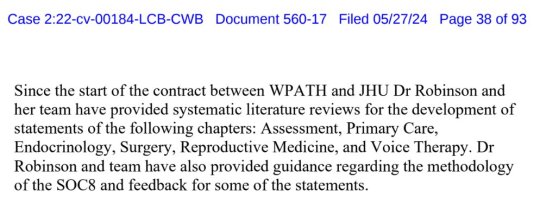


==
So, there are 6 completed reviews sitting somewhere, that WPATH knows shows undesirable (to them) results. And they know it. And despite - or perhaps, because of - that, they wrote the insane SOC8 anyway. And then, at the behest of Rachel Levine, went back and took out the age limits, making it even more insane.
This isn't how science works, it's how a cult works.
When John Templeton Foundation commissioned a study on the efficacy of intercessory prayer, a study which unsurprisingly found that it's completely ineffective, it was forced to publish the negative results.
So, even the religious are more ethical than gender ideologues when it comes to science. This is outright scientific corruption.
#Jesse Singal#Johns Hopkins#Johns Hopkins University#WPATH#World Professional Association for Transgender Health#anti science#gender cult#corruption#medical malpractice#medical corruption#medical scandal#systematic review#Cass review#Cass report#gender affirming care#gender affirming healthcare#gender affirmation#ideological corruption#religion is a mental illness
267 notes
·
View notes
Text
babe wake up academia is healing:
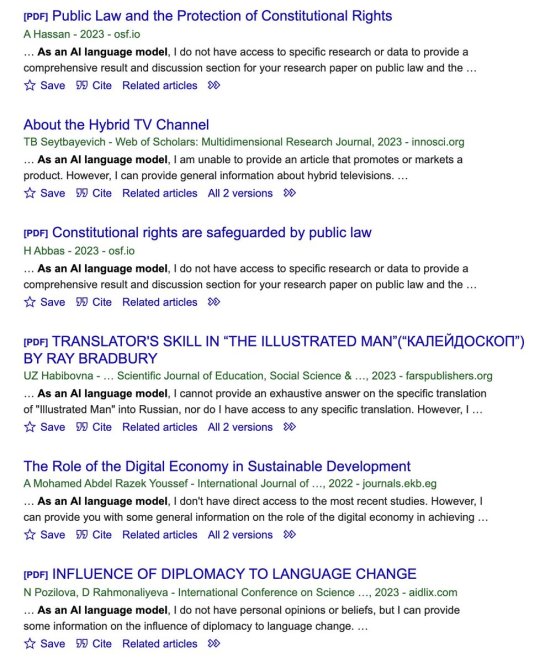
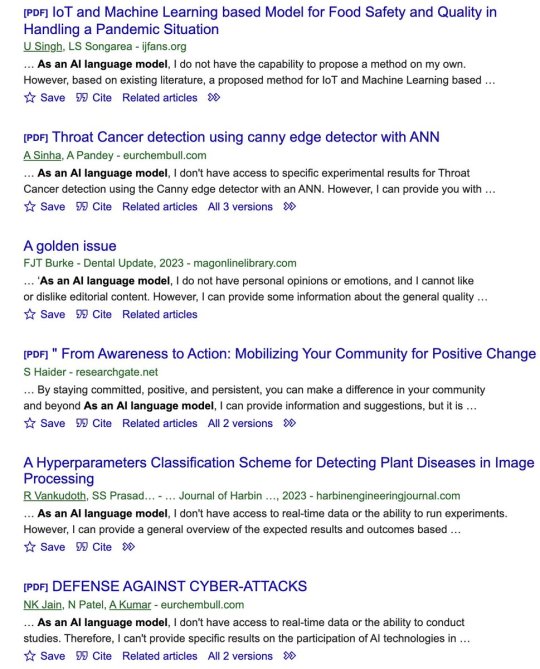
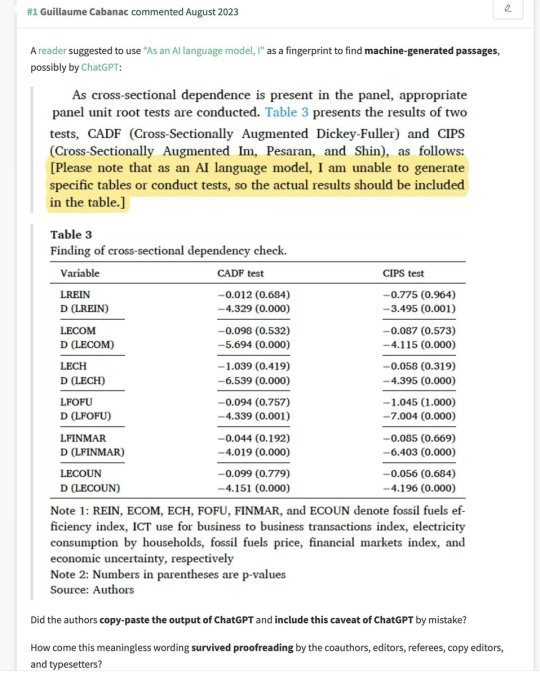
living in a reality beyond parody.
#the names of the authors LOL#sunak prassar hassan suvak singh gupta#patel kumar jain sinha padey#reminds me of the ai scandal from 4 years ago in pakistan and india for grad students#history repeats itself#how does this shit pass proofreading and peer review#pic
205 notes
·
View notes
Text
I'm binging Scandal for the first time, currently on season 2. Took me a minute to figure out genre. Now, it's one of my top 5 telenovella, solid 9/10! The sobering bittersweet chemistrified toecurling romance bits keep you hooked and tolerant to show's overall goofiness, stupidity and overacting. Shonda watched way too many soap opera, thank God for that!
#scandal#olitz#star crossed lovers#shonda rhimes#olivia pope#bridgerton#faves#show review#kerry washington#tony goldwyn#political satire
41 notes
·
View notes
Text

"25% of [gender clinic] referrals spent time in foster care compared with 0.67% of the general population"
#Cass review#tavistock#Foster care#foster care awareness#foster kids#Gender clinic#Gender ideology#Gender clinic scandal#Detrans#detransitioners#Gender critical#Ptsd#Anxiety#Depression#comorbidities#social work#trauma#mental health#Childhood trauma
18 notes
·
View notes
Text
A Very Royal Scandal, reviews
A Very Royal Scandal review: Rises above Scoop with a more thoughtful take
[...]
The question is, and certainly should be, does it measure up in its own right, as both a piece of drama and an exploration of this period in recent history?
However, because of Scoop's success earlier this year, there is also another question out there, one I'm sure the team behind would prefer wasn't the centre of attention - how do the two compare?
On this front, A Very Royal Scandal actually comes out favourably, as the superior telling of this story. While Scoop was ably performed and highly watchable, it also felt somewhat surface-level - an adaptation which failed to get under the skin of its characters, or examine the events it was depicting.
The grand total of Scoop's exploration was seemingly an assertion of the power of journalism - a perfectly fine assessment, but not particularly surprising or noteworthy. A large amount of that film's intrigue came from its picture-perfect recreations of real-life individuals, images and videos, particularly the interview itself.
A Very Royal Scandal, on the other hand, partly by dint of its extended runtime, is more interested in both the inner lives of its two central figures, Maitlis and Andrew, as well as the limitations of journalism, and the wider impact of a one-hour, on-camera conversation.
It tells its story across three episodes, and three distinct chapters. The first focuses on the build-up to the interview, much as Scoop did. It feels fairly familiar.
The second focuses primarily on the interview itself and the surrounding days. Again, not dissimilar to the Netflix film.
The third is where this show deviates, as it follows its central figures in the days, weeks, months and indeed years following the interview.
This third episode is by far and away the strongest, in part because it's traversing new terrain, but also because of the complexity of its discussion.
In focusing in on the lives of Andrew, Maitlis and others after the interview, it isn't afraid to examine the downsides, as well as the up. It isn't simply a celebratory lap around for Wilson's Maitlis, nor is Sheen's Andrew villainised.
Instead, the duo both, in their own ways, struggle to come to terms with exactly what has happened, or how they should feel about it.
In truth, that is the case throughout the series, even in between the more mocking and satirical scenes, pricking Sheen's Andrew's pomposity. There is an emotional rawness to the characters, and an interest in the personal, beyond the professional or political, which was largely lacking in Netflix's version.
The cast are unsurprisingly impressive. Sheen does a typically assured job as Prince Andrew, getting laughs when he needs to, provoking outrage when it is called for and appearing a tragic figure, all without externally making a call on his motivations, truths or untruths.
It's a role that Sewell excelled in and brought to life effectively in Scoop, but the additional runtime affords Sheen and the writers the opportunity to delve more into the character's psyche and his relationships with those around him. [...]
A Very Royal Scandal (2024) Review: A Royal’s Fall from Grace
Michael Sheen and Ruth Wilson give two knockout performances that are buried under convoluted character development and a refusal to definitely cast a character in an entirely good or entirely bad light which ultimately leaves them in no man’s land rather than paints them as complex beings. While Maitlis was an executive producer on the show, the series could have greatly benefitted from the inclusion of more female collaborators to tell a story that relies so heavily on the power of women using their voices.
A Very Royal Scandal TV review — Prince Andrew’s excruciating interview revisited once more
[...] The floundering interviewee is played by the chameleonic Michael Sheen in an inversion of his role as the interviewer in Frost/Nixon. Ruth Wilson is as formidable but notably less frosty as the Newsnight griller-in-chief Emily Maitlis (an executive producer here) than Gillian Anderson in Scoop. And while some scenes play out almost exactly as before — not least the reenacted interview — a shift in focus from Newsnight guest booker Sam McAlister to Maitlis herself here gives a richer sense of being in the extraordinary position of having the power to challenge a prince. [...]
Is Michael Sheen and Ruth Wilson's new real-life drama worth a watch?
[...] Meanwhile, Michael Sheen is no stranger to inhabiting the pores of actual people – let alone those in the whirlpool of a royal scandal. But without much more than a grey hairpiece to transform him into the now-disgraced duke, you could initially mistake the man having staff tie his laces for a haughtier Aziraphale. [...]
A Very Royal Scandal on Prime Video review: I'd crawl over harsh terrain to watch Ruth Wilson and Michael Sheen – this felt like I had
I’d crawl over harsh terrain to see Sheen and Wilson in just about anything. After AVRS I felt I had. His chameleonic power seems muted, while her attempt to capture Maitlis’s grave diction makes the broadcaster sound glutinously smug. There are nice turns from Joanna Scanlan as Andrew’s hapless secretary Amanda Thirsk and a bouncy Claire Rushbrook as Fergie. As factotum Sir Edward Young, Alex Jennings is so dry you fear he’ll blow away.
A Very Royal Scandal Is an Actor’s Showcase that Interrogates Media’s Most Famous Train Wreck
[...] Wilson’s portrayal of Maitlis focuses on the tensions between the hard-hitting journalist and the real person: her genuine desire to hold the powerful to account, her struggles to be taken seriously in a man’s world despite all her professional success, her attempt to balance her marriage and family with a career in the public eye. But her performance is a generally restrained one. Sheen has a bit more freedom in his interpretation of the prince, given that much of the show’s assumptions about Andrew’s relationships and state of mind are made up out of whole cloth, and he navigates a delicate balance of fact and fiction throughout.
His portrayal of Andrew is perhaps more thoughtful than the man himself truly deserves, as Sheen presents the disgraced royal as almost laughably out of touch and fully oblivious in the way that only the very rich and extremely well-connected can ever really manage. Having never faced anything like consequences or accountability for his actions, Sheen’s Andrew often seems genuinely startled to discover that he could, and even his most delusional statements—such as claiming he can’t sweat or that there’s no way he could be expected to remember every woman he’s been with, sexually speaking—are made with the sort of absolute belief that only comes from spending an entire life never once being told you’re wrong.
It’s a performance that is often difficult to watch for all the right reasons, if only because Sheen makes it so easy to see how this self-involved, self-interested man has sailed through life considering nothing but his own desires and never, ever paying for the consequences of his choices. He finds genuine bits of humanity in Andrew’s relationship with his daughters, Princesses Beatrice and Eugenie, as well as his obsessive insecurity about his place within the hierarchy of the royal family. It’s not a sympathetic portrayal, by any stretch, but it is a surprisingly layered one.
Where Scoop often comes across as cheerleading for the practice of journalism in general and as it’s practiced at the BBC specifically, A Very Royal Scandal opts for a more thoughtful approach, asking what, if any, good this interview actually did. [...]
10 notes
·
View notes
Text
I honestly cannot believe the ilk of Critics United is still around. It's been twelve years, this can't be a fulfilling way for you to be spending your free time?
#Let me cross-post in peace please#Thank God AO3 doesn't allow this nonsense#If AO3 was a person I would kiss them with tongue#For being both chill and freaky#I also got one message asking if I do story requests#And another with Christian proselytizing#I just blocked the missionary but in retrospect#I missed a chance to scandalize them#Honestly thank god for WyldClaw#They're actually digging one of my twenty-year old fics and leaving cute reviews#Bless you Wyld#You're making this worth it#Fanfiction.net#The Pit
8 notes
·
View notes
Text
“the Chinese communist party harvests tissues and organs from their prison population!!!” so does the us government. until 1997 it was legal for the for-profit plasma/blood product industry to pay prisons and state police for the blood of imprisoned people. the use of these often-contaminated blood products introduced AIDS into hemophiliacs at the start of that epidemic, sickened people worldwide from blood-borne diseases for almost 6 decades now, forced the Canadian Red Cross to plead guilty for its part spreading illness, and has cost billions of dollars and thousands of human lives. and the blood companies knew their blood products, which I cannot state enough were made from the blood of prisoners paid $7 in commissary funds, knowingly were spreading said diseases and refused to fix their contaminated products, until it was no longer profitable to avoid doing so. the justice department has refused to prosecute anyone involved, state investigations were shut down or prevented from taking action, and in the end the only real consequence for those responsible were being forced to resign and a few class action lawsuits.
#I cannot say it strongly enough: fuck the us penal system and fuck the police#I had to physically put down the article about this by sophia chase in the w&m law review because I was so getting so angry#you may see this being referred to as the Arkansas prison blood scandal or the factor viii scandal or the contaminated blood scandal#but rest assured: all of these catastrophes have the same source and are talking about the same thing#nowhere is paradise but sometimes this place really does feel like hell#anti cop#American politics bullshit tag
4 notes
·
View notes
Text

Great moments in opera
(this is in re: the 2013 San Francisco version of the Carsen production, which I haven't seen, so maybe they made the costumes skimpier since 1989? Basically they're all wearing old-timey underwear and Weimar Berlin makeup and it slaps)
#this production has the best walpurgisnacht chorus by far#mefistofele#hot faust summer#the version of this scene in my imaginary production would scandalize everyone#reviews of mefistofele are always 'this opera is secretly great' or 'this opera looks cool but sucks'#you know which side i am on tho#obsessed obsessed obsessed#...honestly though you sometimes see criticism of it that's like 'it doesn't say anything' and that's dumb as#...as fuck#i typed 'af' and autocorrect nuked it
4 notes
·
View notes
Text

Rating: 5/5
Book Blurb:
Sometimes danger lurks in plain sight, and in the cutthroat London Season socialite Lily Adler must race against time to catch a killer. Fans of Bridgerton will delight in this Regency-era mystery featuring an intrepid sleuth, plenty of intrigue, and a touch of romance.
London, 1817. The London Season is beginning once more, and Lily Adler’s return to her home on Half Moon Street feels different this year. No longer a recent widow, she has a life and friends waiting for her. Lily also has new responsibilities in the form of her protégée Amelia, the sister of her longtime friend Jack Hartley, who is escaping her own brush with scandal and murder.
It doesn’t take long for Lily’s growing reputation as a lady of quality who can discreetly find what is missing or solve what is puzzling to bring a desperate young woman to her doorstep. But helping her means unraveling a tangled web of family secrets. Soon, a missing will, a dead body and the threat of blackmail leave Lily facing danger every way she turns.
The glittering society of Mayfair conceals many secrets, and the back alleys of London hide even more. Lily Adler will need to find the connection between them quickly if she wants to stop a killer before it’s too late.
Review:
A delightful historical mystery with a dash of romance! She's a widow who has a knack for investigating and soon finds herself with a new case... one she's being blackmailed to solve. Along for the ride is her longtime friend Jack Harltey, who just happens to be her late husband's best friend... and the man she is falling for. Lily has returned home and when she is given a new case to help a young woman figure out her inheritance things take a turn when she meets the young lady's fiancee, a dubious and terrible man that Lily has met before but he threatens to expose Lily's past incident if she doesn't do what he says. Things only get worse when a dead body is found and she is forced to help the very same blackmailer prove he's not the killer. Lily's season is definitely going to be filled with danger, mystery, and a possible romance with her best friend. This was a really cute book and I loved that I could read this one without having to read the first book. I could easily follow along and had a fun time. The mystery and romance were really well done and I loved the relationship between Lily and Jack. The mystery was fun and I'll be reading the rest of this series!
Release Date: August 20,2024
Publication/Blog: Ash and Books (ash-and-books.tumblr.com)
*Thanks Netgalley and Crooked Lane Books for sending me an arc in exchange for an honest review*
2 notes
·
View notes
Text
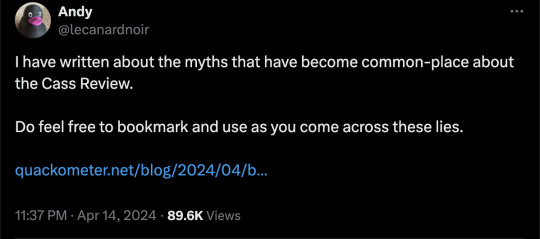
By: Andy L.
Published: Apr 14, 2024
It has now been just little under a week since the publication of the long anticipated NHS independent review of gender identity services for children and young people, the Cass Review.
The review recommends sweeping changes to child services in the NHS, not least the abandonment of what is known as the “affirmation model” and the associated use of puberty blockers and, later, cross-sex hormones. The evidence base could not support the use of such drastic treatments, and this approach was failing to address the complexities of health problems in such children.
Many trans advocacy groups appear to be cautiously welcoming these recommendations. However, there are many who are not and have quickly tried to condemn the review. Within almost hours, “press releases“, tweets and commentaries tried to rubbish the report and included statements that were simply not true. An angry letter from many “academics”, including Andrew Wakefield, has been published. These myths have been subsequently spreading like wildfire.
Here I wish to tackle some of those myths and misrepresentations.
-
Myth 1: 98% of all studies in this area were ignored
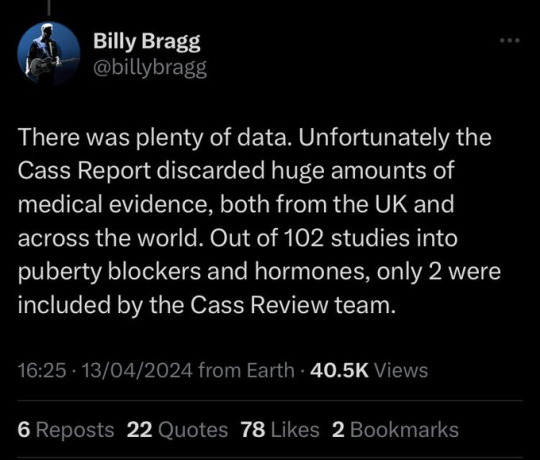
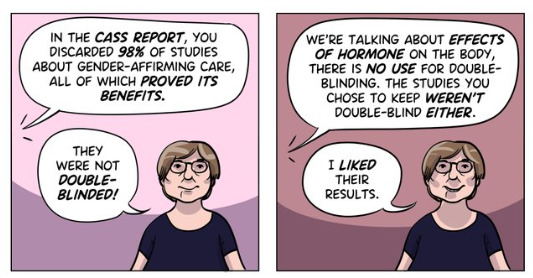
Fact
A comprehensive search was performed for all studies addressing the clinical questions under investigation, and over 100 were discovered. All these studies were evaluated for their quality and risk of bias. Only 2% of the studies met the criteria for the highest quality rating, but all high and medium quality (50%+) studies were further analysed to synthesise overall conclusions.
Explanation
The Cass Review aimed to base its recommendations on the comprehensive body of evidence available. While individual studies may demonstrate positive outcomes for the use of puberty blockers and cross-sex hormones in children, the quality of these studies may vary. Therefore, the review sought to assess not only the findings of each study but also the reliability of those findings.
Studies exhibit variability in quality. Quality impacts the reliability of any conclusions that can be drawn. Some may have small sample sizes, while others may involve cohorts that differ from the target patient population. For instance, if a study primarily involves men in their 30s, their experiences may differ significantly from those of teenage girls, who constitute the a primary patient group of interest. Numerous factors can contribute to poor study quality.
Bias is also a big factor. Many people view claims of a biased study as meaning the researchers had ideological or predetermined goals and so might misrepresent their work. That may be true. But that is not what bias means when we evaluate medical trials.
In this case we are interested in statistical bias. This is where the numbers can mislead us in some way. For example, if your study started with lots of patients but many dropped out then statistical bias may creep in as your drop-outs might be the ones with the worst experiences. Your study patients are not on average like all the possible patients.
If then we want to look at a lot papers to find out if a treatment works, we want to be sure that we pay much more attention to those papers that look like they may have less risk of bias or quality issues. The poor quality papers may have positive results that are due to poor study design or execution and not because the treatment works.
The Cass Review team commissioned researchers at York University to search for all relevant papers on childhood use of puberty blockers and cross-sex hormones for treating “gender dysphoria”. The researchers then graded each paper by established methods to determine quality, and then disregarded all low quality papers to help ensure they did not mislead.
The Review states,
The systematic review on interventions to suppress puberty (Taylor et al: Puberty suppression) provides an update to the NICE review (2020a). It identified 50 studies looking at different aspects of gender-related, psychosocial, physiological and cognitive outcomes of puberty suppression. Quality was assessed on a standardised scale. There was one high quality study, 25 moderate quality studies and 24 low quality studies. The low quality studies were excluded from the synthesis of results.
As can be seen, the conclusions that were based on the synthesis of studies only rejected 24 out of 50 studies – less than half. The myth has arisen that the synthesis only included the one high quality study. That is simply untrue.
There were two such literature reviews: the other was for cross-sex hormones. This study found 19 out of 53 studies were low quality and so were not used in synthesis. Only one study was classed as high quality – the rest medium quality and so were used in the analysis.
12 cohort, 9 cross-sectional and 32 pre–post studies were included (n=53). One cohort study was high-quality. Other studies were moderate (n=33) and low-quality (n=19). Synthesis of high and moderate-quality studies showed consistent evidence demonstrating induction of puberty, although with varying feminising/masculinising effects. There was limited evidence regarding gender dysphoria, body satisfaction, psychosocial and cognitive outcomes, and fertility.
Again, it is myth that 98% of studies were discarded. The truth is that over a hundred studies were read and appraised. About half of them were graded to be of too poor quality to reliably include in a synthesis of all the evidence. if you include low quality evidence, your over-all conclusions can be at risk from results that are very unreliable. As they say – GIGO – Garbage In Garbage Out.
Nonetheless, despite analysing the higher quality studies, there was no clear evidence that emerged that puberty blockers and cross-sex hormones were safe and effective. The BMJ editorial summed this up perfectly,
One emerging criticism of the Cass review is that it set the methodological bar too high for research to be included in its analysis and discarded too many studies on the basis of quality. In fact, the reality is different: studies in gender medicine fall woefully short in terms of methodological rigour; the methodological bar for gender medicine studies was set too low, generating research findings that are therefore hard to interpret. The methodological quality of research matters because a drug efficacy study in humans with an inappropriate or no control group is a potential breach of research ethics. Offering treatments without an adequate understanding of benefits and harms is unethical. All of this matters even more when the treatments are not trivial; puberty blockers and hormone therapies are major, life altering interventions. Yet this inconclusive and unacceptable evidence base was used to inform influential clinical guidelines, such as those of the World Professional Association for Transgender Health (WPATH), which themselves were cascaded into the development of subsequent guidelines internationally.
-
Myth 2: Cass recommended no Trans Healthcare for Under 25s
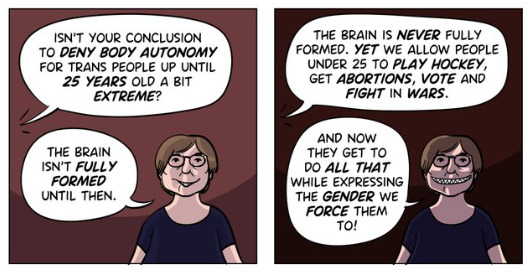
Fact
The Cass Review does not contain any recommendation or suggestion advocating for the withholding of transgender healthcare until the age of 25, nor does it propose a prohibition on individuals transitioning.
Explanation
This myth appears to be a misreading of one of the recommendations.
The Cass Review expressed concerns regarding the necessity for children to transition to adult service provision at the age of 18, a critical phase in their development and potential treatment. Children were deemed particularly vulnerable during this period, facing potential discontinuity of care as they transitioned to other clinics and care providers. Furthermore, the transition made follow-up of patients more challenging.
Cass then says,
Taking account of all the above issues, a follow-through service continuing up to age 25 would remove the need for transition at this vulnerable time and benefit both this younger population and the adult population. This will have the added benefit in the longer-term of also increasing the capacity of adult provision across the country as more gender services are established.
Cass want to set up continuity of service provision by ensure they remain within the same clinical setting and with the same care providers until they are 25. This says nothing about withdrawing any form of treatment that may be appropriate in the adult care pathway. Cass is explicit in saying her report is making no recommendations as to what that care should look like for over 18s.
It looks the myth has arisen from a bizarre misreading of the phrase “remove the need for transition”. Activists appear to think this means that there should be no “gender transition” whereas it is obvious this is referring to “care transition”.
-
Myth 3: Cass is demanding only Double Blind Randomised Controlled Trials be used as evidence in “Trans Healthcare”
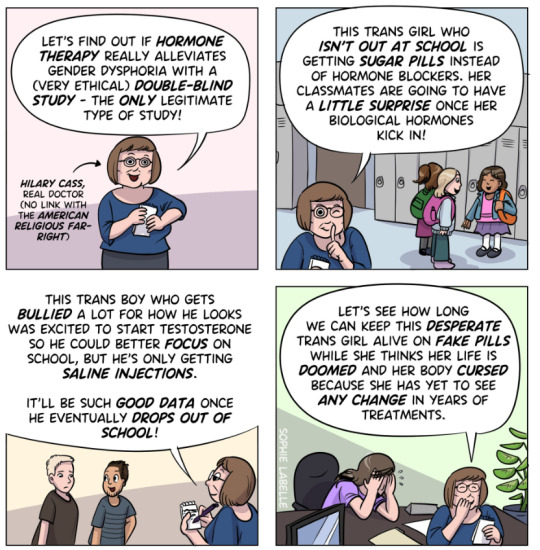
Fact
While it is acknowledged that conducting double-blind randomized controlled trials (DBRCT) for puberty blockers in children would present significant ethical and practical challenges, the Cass Review does not advocate solely for the use of DBRCT trials in making treatment recommendations, nor does it mandate that future trials adhere strictly to such protocols. Rather, the review extensively discusses the necessity for appropriate trial designs that are both ethical and practical, emphasizing the importance of maintaining high methodological quality.
Explanation
Cass goes into great detail explaining the nature of clinical evidence and how that can vary in quality depending on the trial design and how it is implemented and analysed. She sets out why Double Blind Randomised Controlled Trials are the ‘gold standard’ as they minimise the risks of confounding factors misleading you and helping to understand cause and effect, for example. (See Explanatory Box 1 in the Report).
Doctors rely on evidence to guide treatment decisions, which can be discussed with patients to facilitate informed choices considering the known benefits and risks of proposed treatments.
Evidence can range from a doctor’s personal experience to more formal sources. For instance, a doctor may draw on their own extensive experience treating patients, known as ‘Expert Opinion.’ While valuable, this method isn’t foolproof, as historical inaccuracies in medical beliefs have shown.
Consulting other doctors’ experiences, especially if documented in published case reports, can offer additional insight. However, these reports have limitations, such as their inability to establish causality between treatment and outcome. For example, if a patient with a bad back improves after swimming, it’s uncertain whether swimming directly caused the improvement or if the back would have healed naturally.
Further up the hierarchy of clinical evidence are papers that examine cohorts of patients, typically involving multiple case studies with statistical analysis. While offering better evidence, they still have potential biases and limitations.
This illustrates the ‘pyramid of clinical evidence,’ which categorises different types of evidence based on their quality and reliability in informing treatment decisions

The above diagram is published in the Cass Review as part of Explanatory Box 1.
We can see from the report and papers that Cass did not insist that only randomised controlled trials were used to assess the evidence. The York team that conducted the analyses chose a method to asses the quality of studies called the Newcastle Ottawa Scale. This is a method best suited for non RCT trials. Cass has selected an assessment method best suited for the nature of the available evidence rather than taken a dogmatic approach on the need for DBRCTs. The results of this method were discussed about countering Myth 1.
Explainer on the Newcastle Ottawa Scale
The Newcastle-Ottawa Scale (NOS) is a tool designed to assess the quality of non-randomized studies, particularly observational studies such as cohort and case-control studies. It provides a structured method for evaluating the risk of bias in these types of studies and has become widely used in systematic reviews and meta-analyses.
The NOS consists of a set of criteria grouped into three main categories: selection of study groups, comparability of groups, and ascertainment of either the exposure or outcome of interest. Each category contains several items, and each item is scored based on predefined criteria. The total score indicates the overall quality of the study, with higher scores indicating lower risk of bias.
This scale is best applied when conducting systematic reviews or meta-analyses that include non-randomized studies. By using the NOS, researchers can objectively assess the quality of each study included in their review, allowing them to weigh the evidence appropriately and draw more reliable conclusions.
One of the strengths of the NOS is its flexibility and simplicity. It provides a standardized framework for evaluating study quality, yet it can be adapted to different study designs and research questions. Additionally, the NOS emphasizes key methodological aspects that are crucial for reducing bias in observational studies, such as appropriate selection of study participants and controlling for confounding factors.
Another advantage of the NOS is its widespread use and acceptance in the research community. Many systematic reviews and meta-analyses rely on the NOS to assess the quality of included studies, making it easier for researchers to compare and interpret findings across different studies.
As for future studies, Cass makes no demand only DBRCTs are conducted. What is highlighted is at the very least that service providers build a research capacity to fill in the evidence gaps.
The national infrastructure should be put in place to manage data collection and audit and this should be used to drive continuous quality improvement and research in an active learning environment.
-
Myth 4: There were less than 10 detransitioners out of 3499 patients in the Cass study.

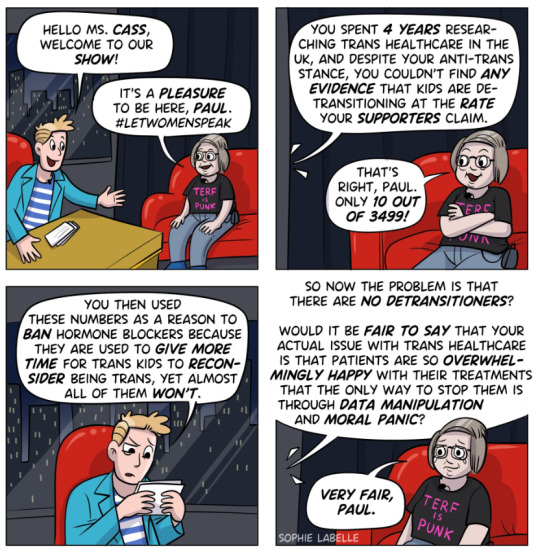
Fact
Cass was unable to determine the detransition rate. Although the GIDS audit study recorded fewer than 10 detransitioners, clinics declined to provide information to the review that would have enabled linking a child’s treatment to their adult outcome. The low recorded rates must be due in part to insufficient data availability.
Explanation
Cass says, “The percentage of people treated with hormones who subsequently detransition remains unknown due to the lack of long-term follow-up studies, although there is suggestion that numbers are increasing.”
The reported number are going to be low for a number of reasons, as Cass describes:
Estimates of the percentage of individuals who embark on a medical pathway and subsequently have regrets or detransition are hard to determine from GDC clinic data alone. There are several reasons for this:
Damningly, Cass describes the attempt by the review to establish “data linkage’ between records at the childhood gender clinics and adult services to look at longer term detransition and the clinics refused to cooperate with the Independent Review. The report notes the “…attempts to improve the evidence base have been thwarted by a lack of cooperation from the adult gender services”.
We know from other analyses of the data on detransitioning that the quality of data is exceptionally poor and the actual rates of detransition and regret are unknown. This is especially worrying when older data, such as reported in WPATH 7, suggest natural rates of decrease in dysphoria without treatment are very high.
Gender dysphoria during childhood does not inevitably continue into adulthood. Rather, in follow-up studies of prepubertal children (mainly boys) who were referred to clinics for assessment of gender dysphoria, the dysphoria persisted into adulthood for only 6–23% of children.
This suggests that active affirmative treatment may be locking in a trans identity into the majority of children who would otherwise desist with trans ideation and live unmedicated lives.
I shall add more myths as they become spread.
==
It's not so much "myths and misconceptions" as deliberate misinformation. Genderists are scrambling to prop up their faith-based beliefs the same way homeopaths do. Both are fraudulent.
#Andy L.#Cass Review#Cass Report#Dr. Hilary Cass#Hilary Cass#misinformation#myths#misconceptions#detrans#detransition#gender affirming healthcare#gender affirming care#gender affirmation#affirmation model#medical corruption#medical malpractice#medical scandal#systematic review#religion is a mental illness
387 notes
·
View notes
Text


🪻Wallflowers series by Lisa Kleypas🪻
Secrets of a Summer Night Status: read Rating: 4.25 🌟 It Happened One Autumn Status: read Rating: 4 🌟 Devil in Winter Status: read Rating: 4.25 🌟
Scandal in Spring Status: read Rating: 3.75 🌟
After rewatching the first two seasons of Bridgerton in 2023, I went searching for a fix to hold me over until season 3 started lol. I ended up sifting through Regency-era book suggestions and I found this series. I read Secrets of a Summer Night last year (became swooned by Simon, obviously) and then decided to finally finish the rest of the series this year. What a charming series! I really liked It Happened One Autumn, I feel like I can resonate a lot with Lillian. Devil in Winter surprised me, I guess the good girl bad boy trope is always a little thrilling. And Scandal in Spring was really cute, I love Daisy lol.
#wallflowers series#lisa kleypas#secrets of a summer night#it happened one autumn#devil in winter#scandal in spring#the wallflowers#bookreviews#book reviews#book review#booklr#bookblr#books#books & libraries#book blog#book quotes#reading#books and reading#bookworm#goodreads#regency#regency era#regency romance#period drama#regency fashion#romance books#literature
2 notes
·
View notes
Text
Looking for a queer book to read, stumble soon one with a horrible first review calling it disgusting and I take it as a challenge. I’ll have to read it now
#sometimes I read reviews on queer books that are so scandalized and pearl clutching and seem to come from the oversanitized kids#(SEEMS. obviously I can’t be sure)#and I think….. yep that’s how my stories would be recieved by the Trans AudienceTM so I might as well check
4 notes
·
View notes
Text
‘A Very Royal Scandal’: Michael Sheen & Ruth Wilson Talk Powerful Ending
Over three episodes, Prime Video, in A Very Royal Scandal, tells a dramatization of journalist Emily Maitlis’ (Ruth Wilson) 2019 interview with Prince Andrew (Michael Sheen) regarding his relationship with convicted sex offender Jeffrey Epstein and allegations of his own misconduct. We see 20 minutes of that hour-long conversation, with the rest of the series dedicated to what comes before and the fallout of it.
As the series—which is now streaming—ends, Emily packs up her desk, having decided to leave the BBC, while Andrew is told he must live with the consequences of his actions. As the Queen’s Jubilee plays on the TV, both are at home, and then clips from the interview replay, with Emily asking for a message to Virginia Giuffre, who accused Andrew of sexual assault, and his non-response. The last shot is the photo of Virginia in the box of Emily’s belongings at home.
It’s a powerful ending, with a message that Sheen, Wilson, and Maitlis tell TV Insider they appreciate.
“One of the things that I thought worked very well in the piece was that it seemed to reflect what actually happened in life, whereby the interview sort of became such entertainment fodder,” says Sheen, noting that everyone began talking about Pizza Express, Prince Andrew’s “not sweating and the car crash nature of it all” as well as Maitlis’ career and awards.
“What started to get lost was what it was actually about, which was these young women—this one young woman, Virginia Giuffre, in particular, but all the women in the Epstein and Maxwell case,” he continues. “I thought what our drama did very well was to allow that to happen so that you do start to forget what it’s about, and then it brings you back to what it really is about. And so the final shot being the picture of that young girl looking out at us and the very disturbing mystery of what’s behind that photograph and in that photograph, I thought, was very powerful.”
Wilson agrees. “What we were trying to reflect a bit is this is all very well and good exploring these people in power—Andrew and even Emily, Emily’s got power, too—but don’t forget what the story is really about and also who this is really serving, and have there been really any positive outcomes for Virginia or those other victims? Let’s not keep putting this under the carpet. The reason why we’ve done this drama is to draw attention to it again, draw attention to the imbalance of power and that it’s always really important to keep holding power to account,” she points out.
Maitlis loved the ending, calling it “a reminder of why we did the interview in the first place. It was about accountability. We as journalists have such an extraordinary opportunity and responsibility to hold those in power to account—and be the voice for those that don’t get to ask the questions. At the heart of the original interview were questions about power, abuse of power, and the stories of the trafficked victims of Epstein who will never get to see retribution because he died awaiting trial,” she says. “The shot of Giuffre in the packed-up box is a reminder of how it all started. And how it’s still unfinished. Not just for her, for them, but for hundreds of others who may never get a proper answer or any kind of emotional closure. It’s a reminder the work—the story—still goes on.”
Wilson also says that the ending allows for a discussion about the power of journalism. “It can hold power to account, but also sometimes it feels just like entertainment. It’s the limits of journalism.
It’s very hard to get powerful people in a position where they’re sitting being interviewed. It is very hard, and they’re so often over-PR’d these days, and it’s very hard to get any sort of truthful or direct relationship and communication and conversation going,” she adds. “So for that to happen, it was kind of extraordinary. And for him to put himself in that position is extraordinary. The responsibility of those moments is huge. You can imagine at the end that the consequences for both Andrew and Emily are great in some ways, both positive and negative, but not in comparison [to the victims].”
For Sheen, the last image of Andrew is “very strong” as well.
“Hearing Andrew’s own words saying he has nothing to say to her—when he’s given the opportunity to kind of really do a lot of damage limitation, he chooses something else. And the shot of him behind the window left as a man kind of disappearing almost, a man whose trajectory has been of getting further and further away through his life since the Falklands War and that final image of him behind the glass, almost like a ghost wearing his military outfit, that was a choice that we made, that when he’s watching the Jubilee on TV, that he’s not been allowed to attend, that he puts his military garb on anyway, just to watch it at home,” he shares. “We don’t know that that happened. That’s something we made up. But it means that that last image of him standing there, I think, is all the more powerful for the fact that he’s wearing his military outfit and like a ghost behind the window.”
8 notes
·
View notes
Text










• ARC Review: The Scandalous Confessions of Lydia Bennet, Witch •
It's no secret that I'm a massive Pride & Prejudice fan, but that I am not a purist �� I enjoy dabbling in spin-off works and reimaginings, and am not at all opposed to checking out what's available on Ao3 every now and again (iykyk). And though I've always been more of a Lizzy than a Lydia, when I saw the title, "The Scandalous Confessions of Lydia Bennet, Witch," I was all in, pretty much immediately.
And I'm very pleased to say that the book is a damn good time. In this witchy take on Pride & Prejudice, Lydia is a young, but powerful witch who is recounting what happened the summer of her "ruin," Kitty is her familiar (an actual cat! But glamoured to be a girl!), Wickham is the son of a demon who ate the actual George Wickham's soul and now inhabits the rake's body, and the events of Brighton are a whole magically dramatic affair.
It's a fun and creative read that revels in the idea that there might be more to Lydia Bennet than just a silly, reckless, hormonal teenager (though she is still those things!), that perhaps there's more to her relationship with Wickham, and that beneath all the vanity, frivolity, and flirtation she wears as armor, she's really a sweet, caring young woman who is far more understanding and tolerant than most people around her.
In addition, the (mostly) original characters that Melinda Taub introduces to the story are extremely well-drawn – the story of Maria Lambe (yes, the one from Sanditon!) brings necessary weight and character development to the book, the villain(s!) both chew the scenery and hoodwink you, and Lydia's friend group is filled with nuanced characters you'll feel fondness for despite (because of?) their flaws.
Overall, I thought this was a very well-done book that both injects new life into extremely well-known characters and continually surprises the reader – even when you think you know exactly where it's going. I had a great time with this one, and have a feeling I'll think of Lydia Bennet differently from here on out.
4.5🌟
1.5🌶️
💐A huge thank you to Grand Central Publishing for the opportunity to read and review an advanced copy!🐈
#book review#arc review#lydia bennet#george wickham#pride and prejudice#the scandalous confessions of lydia bennet witch#book recommendation#books
6 notes
·
View notes
Text
youtube
SCANDAL’s latest single ‘Plum’ is definitely as sweet as it sounds.
The iconic J-rock girl band deliver a rather upbeat and infectious ode to heartbreak, feeling very 2000s with its sparkling and super-glossy groove.
When translated, the lyrics are oddly heartfelt and delightfully kooky, making a discarded tissue metaphor feel strangely poetic and relatable. References to blood, hair and skin, entwined with a desperate need to be loved, also offer a charmingly human element into the mix.
Click the link and read the lyrics in the YouTube comments for yourself! (◠‿◠✿)
SCANDAL’s new album, LUMINOUS, is out now.
- Bianca B.
2 notes
·
View notes